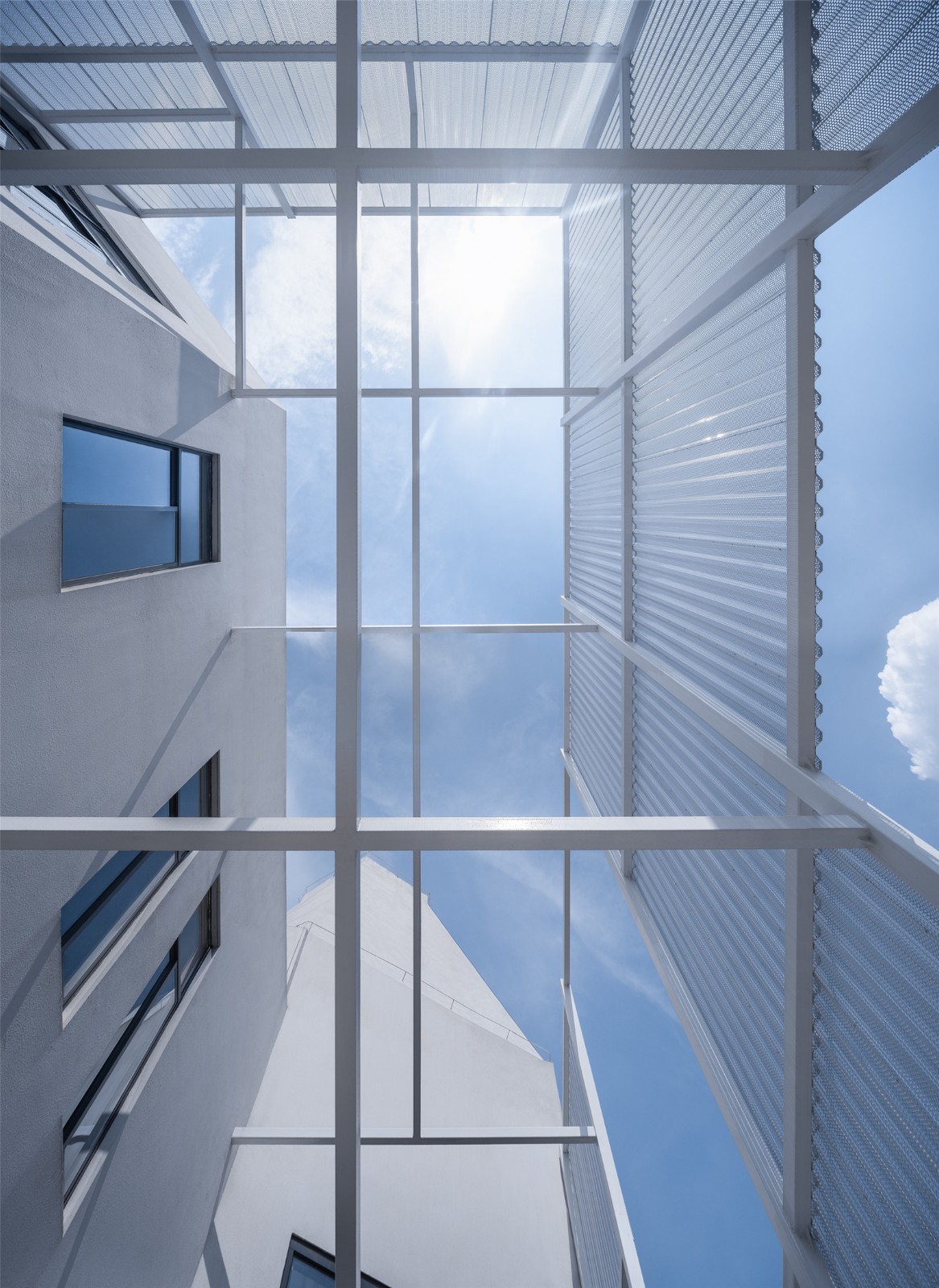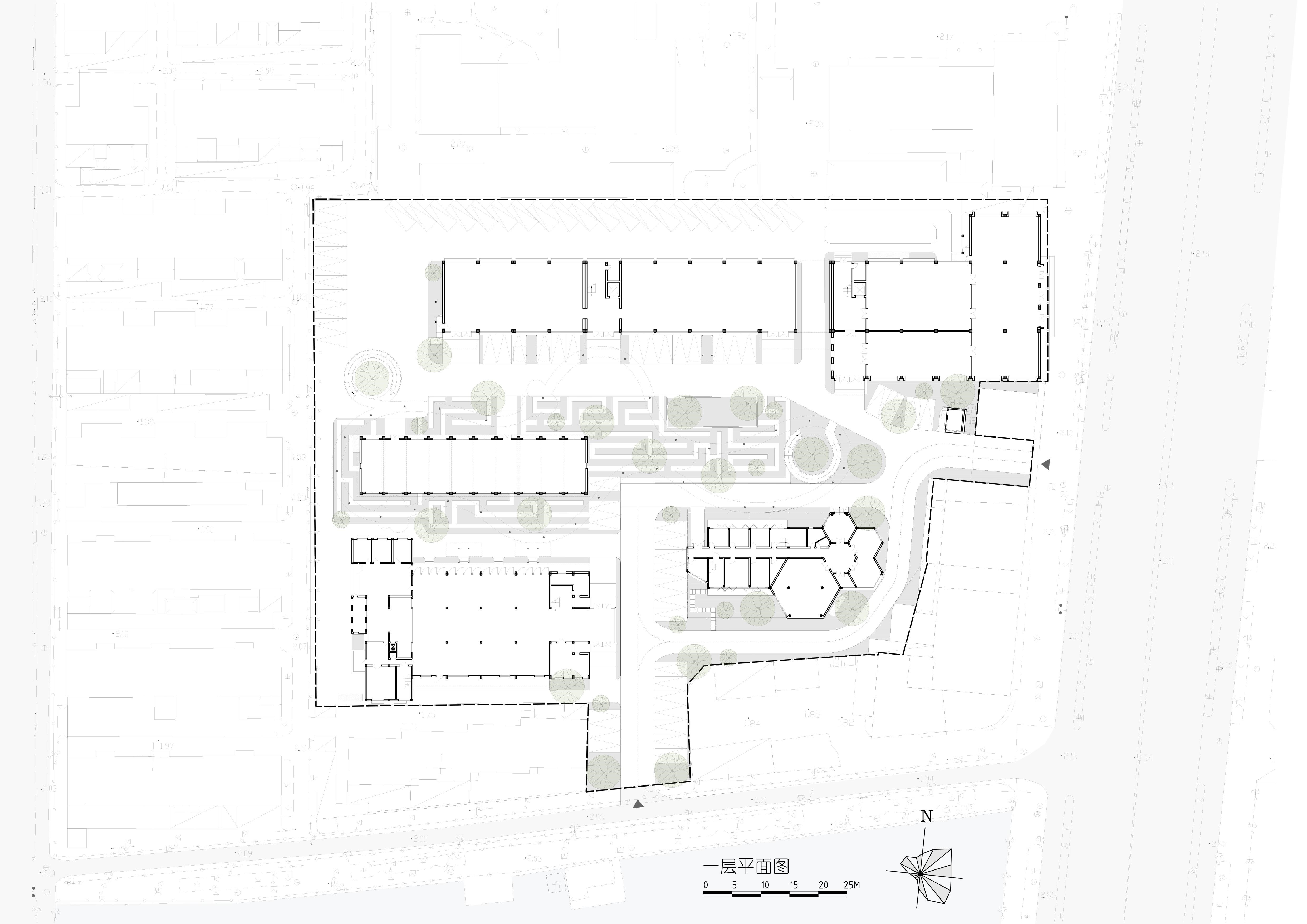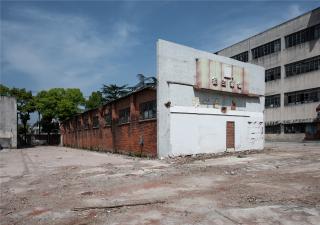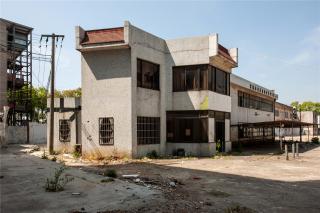江南绣衣厂建筑设计 | 米丈建筑
-
项目名称:江南绣衣厂
-
项目地点:江苏省常熟
-
项目规模:9726 m²
-
设计公司:
-
委托方:江苏江南商贸集团有限公司
-
建成时间:2021
-
图片来源:吴清山 卢志刚
▼鸟瞰图 ©吴清山
Overall ariea view after reconstruction © Wu Qingshan

▼云间彩虹 ©吴清山
Rainbow among clouds ©Wu Qingshan

常熟作为中国重要的轻纺工业集聚中心,在城市的发展过程中,以纺织业生产场所为代表的轻工业厂房,成为了城市中重要的建筑类型。常熟绣衣厂成立于1979年,1989年整体搬迁至海虞南路77号,开始了一段在城市中心区域的辉煌时光。随着中国社会的快速发展,生产让位于消费,产业和城市都在几十年内发生了天翻地覆的变化,从而引发了城市建筑功能的彻底转变。因得益于特殊的地段优势,绣衣厂的运营模式由生产经营逐渐转变为了厂房建筑出租,建筑得以持续高频率使用。但伴随着被过度使用而造成了建筑破损、基础设施老旧,使建筑群逐渐成为繁华市中心的负面空间。2019年,常熟江南集团在现有基础上开始改造整修,以期重新唤醒她的活力与价值。
Changshu is a vital textile industry gathering centre in China. In the city development process, textile workshop, represented by textile manufacturing sites, becomes the essential architectural type in the city. Changshu embroidered garment factory founded in 1979. It entirely moved to Haiyu South Road No.77 and started a glorious time in the city centre. With the rapid development of Chinese society, giving way to consumption, earth-shaking changes have taken place in industries and cities over the past few decades, which have led to the complete transformation of urban-architecture functions. Benefiting from the particular location advantages, the operation mode of the Jiangnan embroidery garment factory has gradually changed from production management to building rental, and the buildings have been used continuously and frequently. However, with the excessive use, the buildings are damaged and the infrastructure is old, which makes the buildings gradually become a negative space in the downtown. In 2019, Changshu Jiangnan Group started the transformation and renovation on the factory's existing basis to awaken its vitality and value.
▼改造前鸟瞰
Aerial view before reconstruction

▼改造后鸟瞰 ©吴清山
Overall ariea view after reconstruction © Wu Qingshan

▼总体轴侧
Axonometric©MINAX

项目由四幢多层建筑构成,占地面积为10000平方米,总建筑面积为9726平方米。经过设计团队仔细的现场勘查与分析后,秉持着充分尊重历史和现状的态度,仅拆除并重建一栋破损严重、已为危房的砖结构原辅料用房,其余的生产车间、办公楼、餐饮厅皆在保留其原有结构基础上进行局部加固。但如何能在老建筑中植入新的使用功能,从而塑造出新的富有活力的使用场景和形象,成为本次改造提升的重点。特别是对于这样一个城市核心地域的建筑群体来说,不仅要保持城市记忆,还要适应时代有新的发展需求。在旧改的过程中,必须加入创新的元素,从而实现一种可持续的有机变化。这种变化不是依靠新对旧的覆盖,而是将这种历史的关系在时间的维度上并置起来,形成既能满足城市新功能的要求,又能留下铭刻发展的清晰痕迹。
The project comprises four multistory buildings, covering an area of 10000 square meters and a total construction area of 9726 square meters. After careful on-site investigation and analysis, the design team upholds the attitude of fully respecting the history and current situation, and only demolished and rebuilt one brick structure raw auxiliary building that is seriously damaged and has become a dangerous building. The rest of the production workshop, office building and restaurants have been partially reinforced to retain their original structure. However, implanting new using functions to the old building to create new dynamic use scenarios and images has become the focus of this transformation and improvement. Especially for such a building group in the core area of the city, it is necessary not only to maintain the city's memory but also to adapt to the new development needs of the times. Therefore, innovative elements must be added in the process of renovation to realize a sustainable organic change. This change does not rely on new things to cover the old. Still, it juxtaposes this historical relationship in the dimension of time, which can not only meet the requirements of new urban functions but also leave a clear trace of recorded development.
▼改造前建筑
Building before reconstruction





▼改造后建筑鸟瞰 ©吴清山
Ariea view of the building © Wu Qingshan

通过对原有建筑相互关系及未来功能的分析,这些差异性巨大、性格各异的建筑间需要形成有机的生态,建筑和场地间感受属性需要由原来的单一体验转变成具有记忆性的复合感知,这就要求场所中需要介入有强有力的创新元素。这种新的元素在介入的过程中,一方面保持场所记忆,另一方面给原有秩序带来全新的冲击,从而发出应对当下生活的回音,能够让项目在更长的时间轴上叠现光阴的厚度。
By analyzing the relationship between the original buildings and their future functions, these buildings with huge differences and different personalities need to form an organic ecology. The feeling attribute between buildings and sites needs to be transformed from the original single experience into a composite perception with memory, which requires strong innovative elements to be involved in the sites. On the one hand, in the process of intervention, this new element maintains the memory of the place. On the other hand, it brings a brand-new impact on the original order to send an echo to deal with the current life, which can make the project show the thickness of time on a longer time axis.
▼现状分析
Condition Analysis©MINAX

▼城市入口©吴清山
Entrance to the park©Wu Qingshan

▼夜的甬道©吴清山
Night corridor©Wu Qingshan

“云”本身是一个抽象的语言,却是中国传统山水画中最写意的部分。云在画中划分了峻岭山峰,隐藏了亭台楼阁,它看似遮盖了事物,却能激发每一位观看者的个人经验和想象,成为画意中最有趣的部分,这可以称之为最早的精神互动。我们以“云”作为造型元素,藉云的飘逸自由,创造出独特的行走体验,也让原来建筑真正与人互动起来。建筑的差异性从而被新的元素语言弥合,它不再是伫立的孤岛,而是场地上最有趣的表情。
"Cloud" itself is an abstract language, but it is the part that can best describe the artistic conception in Chinese traditional landscape painting. Clouds divide mountains and hide pavilions in the painting. It seems to cover things, but it can stimulate everyone's personal experience and imagination, and become the most interesting part of the painting, which can be called the earliest spiritual interaction. We take "cloud" as the modeling element and create a unique walking experience with the help of the elegance and freedom of the cloud, which also makes the original building truly interact with people. The new element language integrates the difference of architecture. It is no longer a standing island, but the most fascinating expression on the site.
▼概念分析
Conceptual Diagram©MINAX

▼云廊勾勒出新的天空轮廓©吴清山
The cloud corridor outlines a new sky©Wu Qingshan


▼云下的风景©吴清山
Cloud scenery©Wu Qingshan

▼云过红墙©卢志刚
Clouds over the red wall©Lu Zhigang

建筑的“新”是相对于“旧”的诗意重组。我们以一条飘浮灵动的云廊置入到原本坚硬肃穆的建筑体间。云廊弥合了建筑,填补了空隙,让人的脚步脱离地面的束缚后展开一场在时间和空间中的浪漫旅程。原本直白而乏味的场所,由于云廊的介入,产生了积极的变化,空间轮廓和维度被重新划分。云廊以一种柔和的姿态建筑间的场地上诞生出新的形状,我们随着云廊的蜿蜒和起伏在建筑间游走。
The "new" of architecture is a poetic re-combination relative to the "old". We put a floating clever cloud corridor between the original hard and solemn building volumes. The cloud corridor integrated with the architecture, filling the gap, and allowing people to embark on a romantic journey in time and space after breaking away from the shackles of the ground. The original straightforward and boring place has undergone positive changes after the intervention of the cloud corridor, and the spatial outline and dimension have been re-divided. The cloud corridor gave birth to a new shape on the site of the building with a gentle gesture, and we wandered around the buildings along the winding and undulation of the cloud corridor.
▼新与旧的诗意组合©吴清山
New and old poetic combination©Wu Qingshan

▼新旧并置©吴清山
Juxtaposition of old and new©Wu Qingshan

▼云廊飞渡©吴清山
Cloud corridor Flyover©Wu Qingshan

▼红砖墙与廊桥 ©吴清山
Red brick wall and corridor bridge©Wu Qingshan

▼云廊与树影 ©吴清山
Cloud corridor and tree shadow©Wu Qingshan

▼穿越与连接©卢志刚
Crossing and connection©Lu Zhigang

▼新与旧的图景©吴清山
New and old ©Wu Qingshan

中国的既有建筑改造经历了不同的阶段,从覆盖式的拆除新建,到原汁原味的保留更新,对于不同的操作对象,理应有不同的方式。基于创新的旧改,是真正使建筑焕发持续生命力,适合时代发展最有效方式之一。江南绣衣厂是我们对于这种创新的旧改策略的全新实践。建筑的真正价值是其使用价值。在使用过程中,不同使用者所带来的丰富而个性的生活印记,才能使建筑长久的为人服务、与时代和社会共存,成为时代发展的记录者。
The reconstruction of existing buildings in China has gone through different stages, from covering new construction after demolition to complete retention and renewal. There should be other ways for different operation objects. Innovation based transformation is one of the most effective ways to truly make buildings glow with sustainable vitality and adapt to the development of the times. Jiangnan embroidery garment factory is our entirely new practice of this innovative transformation strategy. The real value of architecture is its use-value. In the process of use, the rich and individual life imprints brought by different users can enable the building to serve people for a long time, coexist with the times and society, and become the recorder of the development of the times.
▼将老建筑包围的云廊©吴清山
The cloud corridor surrounds the old building©Wu Qingshan

当我们再审视江南绣衣厂的时候,她已不仅仅是作为过往的生产场地,也不仅仅是现在的文创园区,而是成为这个时代的时间切片,为未来而来。那些留存的建筑与新筑的云廊,依旧是不完整的,只有当人影从云廊闪过,在场地上留下嬉笑与喜悦,才是一个完整的画面。恰似卞之琳的《断章》诗句:
When we review Jiangnan embroidery garment factory, it has become a previous production site, not just the current cultural and creative park, but also a time slice of the current era and come for the future. The remaining buildings and the newly built cloud corridor are still incomplete. It is a complete picture only when figures flash through the cloud corridor and leave laughter and joy on the site. Just like Bian Zhilin's poem "Duan Zhang":
▼连接与重构©吴清山
Connection and reconstruction©Wu Qingshan

▼环廊©吴清山
Circular corridor©Wu Qingshan

▼环廊©吴清山
Circular corridor©Wu Qingshan

▼环廊树影©吴清山
Circular corridor and tree shadow©Wu Qingshan

你站在桥上看风景,
看风景人在楼上看你。
明月装饰了你的窗子,
你装饰了别人的梦。
You stand on the bridge watching the scenery,
The scenery viewer watches you from the balcony.
The glorious moon adorns your window,
You adorn another’s dream.
▼夜色下的云影©吴清山
Cloud corridor and sunset glow©Wu Qingshan


▼夜的云廊©吴清山
Cloud corridor at night©Wu Qingshan

▼天空云影©吴清山
Sky cloud shadow©Wu Qingshan



▼云兴霞蔚©吴清山
Cloud corridor and sunset glow1©Wu Qingshan

▼城市鸟瞰©吴清山
Aerial view of the city©Wu Qingshan

▼总平面图
Site Plan©MINAX

▼构成分析
Breakdown drawing©MINAX

▼新旧对比
Before vs After




▼一层平面图
Floor Plan - Level 1n

▼二层平面图
Floor Plan - Level 2

▼三层平面图
Floor Plan - Level 3

▼四层平面图
Floor Plan - Level 4

项目信息
项目位置:江苏省常熟
面积: 9726 m²
项目年份: 2021
摄影师: 吴清山 卢志刚
主持建筑师:卢志刚 设计团队:黄聪毅、刘志睿、赵瑞雪、刘畅
结构顾问: 苏州安省建筑设计有限公司
业主: 江苏江南商贸集团有限公司
Architects: Minax Architects
Area: 9726 m²
Year: 2021
Photographs: Wu Qinshan ,Lu Zhigang Lead Architect: Lu Zhigang, Project Team: Huang Congyi, Liu Zhirui, Zhao Ruixue, Liu Chang
Construction:Suzhou Ansheng Construction Design Consulting Co., Ltd.
City:Changshu
Country:China
版权声明:本文版权归原作者所有,请勿以景观中国编辑版本转载。如有侵犯您的权益请及时联系,我们将第一时间删除。
投稿邮箱:info@landscape.cn
项目咨询:18510568018(微信同号)



























































